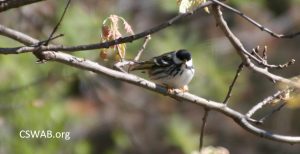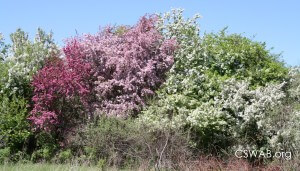By Mimi Wuest
More and more treasures are being found on the land at the old Badger Army Plant. Citizens for Safe Water Around Badger (CSWAB) has been running a series on their Facebook page of some of the birds that were seen at Badger during the month that it was open to the public. Recently they have posted photos of a scarlet tanager, a bobolink, an indigo bunting, a cedar waxwing, a black and white warbler, a bluebird, a chestnut sided warbler, a blue gray gnatcatcher, a towhee, a kingbird, a grey-cheeked thrush, a palm warbler, a yellow warbler, a lesser yellowlegs, a goldfinch and a Baltimore oriole, all observed this spring at Badger.
These birds are at home at Badger because of the wide expanses of undisturbed woods and grasslands that are available to them. We have the chance to protect and restore some of our very rare and endangered grassland birds when we restore the land at Badger. Their presence is a bonus for visitors who will come to the prairie to hike or cycle or picnic or camp, and it is a real draw for the thousands of bird watchers in the state.
Recently, a new treasure has been identified at Badger. The landscape is dotted with venerable old apple trees, a tribute to the early farmers who were displaced by the Army in the 1940’s. Many of these trees are still producing apples, and some may be heirloom apples that are to be found nowhere but on the Badger lands. As a bit of an antique myself, I really like the idea of restoring this antique apple trees.
Recently, a group of enterprising explorers who call themselves The Apple Corps, have undertaken to locate as many of the Badger apple trees as they can, with the hope of identifying them and ultimately restoring them to health and productivity. The trees are scattered all over the property, growing on Dairy Forage land, DNR land and the land that is slated to come to the Ho Chunk Nation. This gives the property owners the opportunity to work cooperatively on a preservation project. This kind of cooperative management of the land is what was intended in the Reuse Plan for the property.
It could be that these old apple trees will manage to do what commissions and committees have been trying to do for many years: encourage communication and cooperation between the current and future land owners at Badger. And if the DNR eventually announces that the portion it controls will be open to the public for education, prairie restoration and low impact recreations, perhaps we can toast their decision with a glass of Badger cider!



